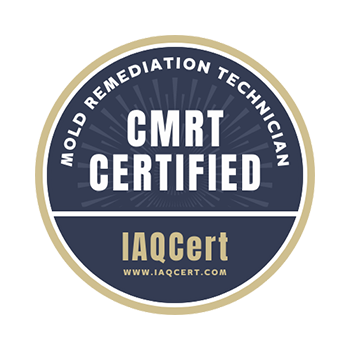Certified Mold Remediation Technician (CMRT)
Become a Certified Mold Remediation Technician (CMRT) with IAQCert. This comprehensive course covers identifying, assessing, and remediating mold issues in residential, commercial, and industrial environments. You’ll gain essential skills through theoretical learning and practical applications, including data interpretation, strategy development, documentation, and regulatory compliance. Upon completion, you’ll earn the CMRT certification, enhancing your career prospects in the IAQ industry. Boost your professional edge or start a new career with our CMRT course.
Overview
Certification
As a CMRT-certified technician, you’ll provide professional mold remediation services that help restore and maintain healthy indoor environments.
This Assessment-Based Certificate (ABC) program validates your expertise in contamination control, moisture management, and safe remediation practices, reflecting your commitment to recognized industry standards. After passing the exam, you can proudly display your digital IAQCert badge on your website, flyers, or social media to showcase your verified professionalism and dedication to effective mold remediation.
Learning Approach
1. LearnEase
Ideal for beginners, offering 34 engaging lectures across 10 comprehensive modules. Engage at your own pace and use the extensive material as a valuable resource bank.
2. CertFast
Perfect for experienced professionals. A focused 1-hour exam to validate your skills quickly, bypassing the extended learning modules.
Learning Outcomes
- Identify mold problems and their sources.
- Understand mold remediation principles.
- Select appropriate assessment methods and equipment.
- Interpret results and develop remediation strategies.
- Communicate effectively with property owners and stakeholders.
- Maintain accurate documentation.
- Comply with relevant regulations and guidelines.
- Recognize emerging issues and trends in mold remediation.
Offering both a Comprehensive Learning Path (LearnEase) and a Fast-Track Exam Path (CertFast), our CADCT course equips you with essential skills and knowledge to excel as an Mold Remediation Technician.
Enrollment & Certification Policy
Your enrollment includes full access to all course materials and the final exam for one year from your original date of enrollment. Certification is awarded immediately upon successfully passing the exam, and it remains valid until one year from your initial enrollment date. Students who enroll in a Technician Certification are eligible to receive one Safety course of their choice free of charge. To redeem this benefit, please contact IAQCert support after completing your Technician course enrollment.
Curriculum
Curriculum
- 10 Sections
- 34 Lessons
- 52 Weeks of Access
- Introduction to Indoor Air Quality (IAQ) and Mold3
- Basic Mycology and Mold Assessment4
- Mold Remediation Principles and Techniques4
- Health and Safety3
- Legal and Ethical Considerations4
- Mold Remediation Project Planning and Management4
- Communication and Customer Service4
- Business Practices for Mold Remediation4
- Advanced Topics in Mold Remediation4
- CMRT Certification Exam5




